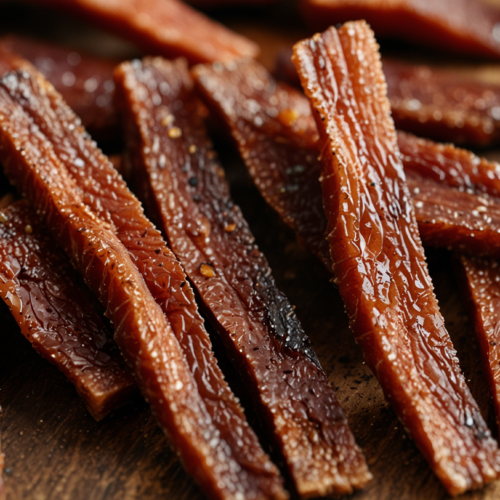
salmon jerky
Discover how to make delicious, homemade salmon jerky with this easy recipe. Packed with protein and perfect for snacking anytime!
Ingredients
Essential Ingredients
- Fresh salmon fillets 1–2 pounds: Look for high-quality, skinless fillets. Wild-caught salmon works best for a richer flavor, but farm-raised is fine if that’s what you have.
- Soy sauce ½ cup: This forms the base of your marinade, adding a savory, umami depth.
- Brown sugar 2 tablespoons: Balances the savory elements with a touch of sweetness.
- Garlic powder 1 teaspoon: Enhances the marinade with a warm, aromatic kick.
- Smoked paprika 1 teaspoon: Adds a subtle smokiness that pairs beautifully with the salmon.
- Black pepper ½ teaspoon: For a gentle heat and extra flavor.
Instructions
Prep the Salmon
- Slice the fillets: Using a sharp knife, cut the salmon into thin, even strips about ¼ inch thick. For best results, slice against the grain to achieve a tender texture.
- Remove the skin: If the fillets have skin, carefully peel it off before slicing.
- Pro Tip: Slightly freezing the salmon for 20–30 minutes beforehand makes it easier to slice evenly.
Make the Marinade
- In a large mixing bowl, whisk together the soy sauce, brown sugar, garlic powder, smoked paprika, and any optional ingredients you’ve chosen (like honey or red pepper flakes).
- Stir until the sugar dissolves completely, creating a smooth, flavorful marinade.
Marinate the Salmon
- Place the salmon strips in a resealable plastic bag or a shallow dish. Pour the marinade over the salmon, ensuring each piece is fully coated.
- Seal the bag (or cover the dish) and refrigerate for at least 6 hours, preferably overnight. This allows the salmon to absorb the flavors deeply.
- Tip: Give the bag a gentle shake halfway through marinating to redistribute the liquid.
Prepare for Drying
- For an oven: Preheat your oven to 175°F (80°C) and line a baking sheet with parchment paper or a wire rack.
- For a dehydrator: Set the temperature to 145°F (63°C) and arrange the trays.
- Remove the salmon from the marinade, letting any excess drip off, and lay the strips out in a single layer. Avoid overlapping for even drying.
Dry the Salmon
- Oven method: Place the baking sheet in the oven and leave the door slightly ajar to allow moisture to escape. Bake for 3–4 hours, flipping the salmon halfway through.
- Dehydrator method: Let the salmon dry for 4–6 hours, checking periodically for doneness.
- The salmon jerky is ready when it’s firm, slightly chewy, and no longer sticky to the touch.
Cool and Store
- Allow the jerky to cool completely before transferring it to an airtight container or resealable bag. Store it in the refrigerator for up to 2 weeks, or freeze for longer shelf life.
Notes
Nutrition Information (Per Serving)
- Calories: 150–200 kcal
- Fat: 7g
- Protein: 25g
- Carbs: 5g
- Fiber: 1g
- Sugar: 2g
- Sodium: 500–600mg (varies based on soy sauce used)
- Omega-3s: 2g (approx.)